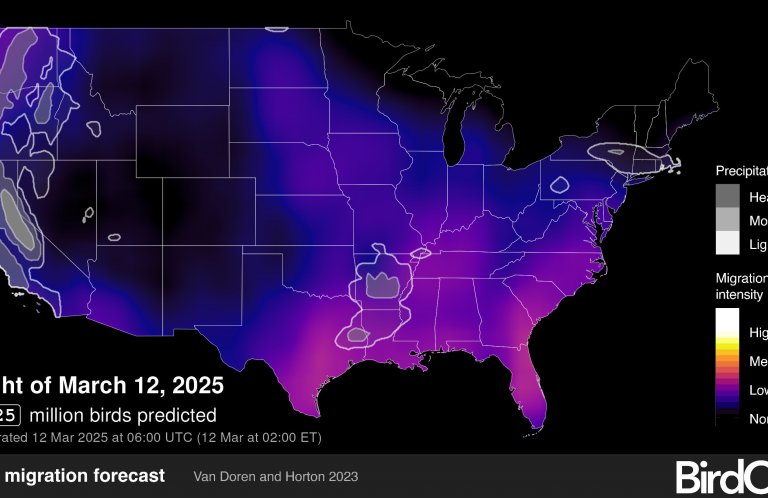Russian Ban on Drift Net Fishing Bodes Well for Seabirds
When Russian President Vladimir Putin approved a law this month that will end drift net fishing in an offshore fishing zone in the North Pacific, he took an important step that will save tens of thousands of seabirds each year.
Conservationists had long pushed for Russia to ban this fishing technique, which uses hanging nets that extend up to 30 miles.

Thirty-two seabird species, including the Common Murre, perished in drift nets in the Russian Exclusive Economic Zone, according to one study. Photo: Bildagentur Zoornar GmbH/Shutterstock
Marine mammals, seabirds, and fish become fatally trapped in the long nets. According to Russian scientists, more than 1.2 million seabirds and 15,000 marine mammals died in the Russian salmon drift net fishery from 1993 to 1999. More-recent estimates of seabirds killed from 1999 to 2008 were based on provisional data, but suggest an average of 93,000 birds each year.
Along with these troubles come economic losses: Russia's Audit Chamber calculated the total damage and loss of fish from drift net fishing is more than 10 billion rubles, about $17 million.
“Passage of this bill is a big win for anyone who cares about the conservation of birds, salmon, and porpoises in the Russian Far East,” Sergey Korostelev, Marine Program Coordinator of the Worldwide Fund for Nature's Kamchatka Bering Sea Regional Office, said in a written statement.
Kudos go to WWF and others who pushed for the introduction of the bill and conducted extensive assessments to quantify the harmful impacts of drift net fishing.
End of a Net-fishing Era
The ban, which takes effect in January, is the final chapter in an international push to halt this type of net fishing. In 1992, the United Nations banned the use of large-scale drift nets to harvest salmon or any other fish species on the high seas. Nonetheless, drift gillnetting continues to be practiced inside the Exclusive Economic Zones of many nations, including the United States. Together, these fisheries cause the accidental deaths of hundreds of thousands of seabirds worldwide. Putin's action has ended a particularly destructive fishery.

Birds such as the Sooty Shearwater are found caught in drift nets. Photo: Greg Lavaty
The news comes none too soon for the many species that encounter the hanging curtains. The longer the net, the slimmer the chance that a bird — or a traveling whale or dolphin — will be able to avoid it.
Diving Birds at Risk
A 2008 report by Russian scientists noted that drift nets killed 32 different species from 1992 to 2008, affecting diving birds of every sort: Red-throated and Yellow-billed Loons, Red-faced cormorants, Parakeet Auklets, and Crested Auklets, to name a few.
The nets can capture an entire flock of birds, such as Short-tailed and Sooty Shearwaters, which gather by the thousands, killing many individuals at once. The nets indiscriminately catch anything that comes into their path.
Left out for hours or days, drift nets attract still more seabirds. Surface-feeding albatrosses, storm-petrels, and kittiwakes also perish, the report said, likely becoming entangled as they attempted to scavenge fish in the net.

Crested Auklets, along with many other birds and marine wildlife of all kinds, will benefit from the ban. Janelle Lugge/Shutterstock
Bycatch — the unintended catch of birds and mammals — is not something that either fishermen or environmentalists want. Gear is lost and damaged; deckhands recovering the catch confront unnecessary risks.
But let's face it: People still want to eat their barbequed salmon and bagels and lox. Hopefully this new ban marks a change in how fisheries are managed to benefit not only birds, but entire ecosystems, too.
(Editor's note: You can help! Visit our Fisheries Program pages to learn more, and see suggestions on ways you can take action to help save seabirds.)
 Hannah Nevins is ABC's Seabird Program Director, based in Santa Cruz, California. She has spent more than 20 years studying seabird ecology in Alaska, Hawai'i, and Antarctica. Her previous research interests include quantifying the impacts of oil spills, disease, and bycatch on seabirds in the California Current and working to conserve Sooty Shearwaters in New Zealand.
Hannah Nevins is ABC's Seabird Program Director, based in Santa Cruz, California. She has spent more than 20 years studying seabird ecology in Alaska, Hawai'i, and Antarctica. Her previous research interests include quantifying the impacts of oil spills, disease, and bycatch on seabirds in the California Current and working to conserve Sooty Shearwaters in New Zealand.


















































